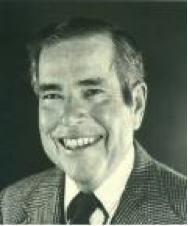Words from Founding Chair Dr. Cliff Jones
Suicide is a high concern for a broad range of professional people helpers.
In 1966, some 28 professionals from law, education, medicine, religious institutions, psychology, and law enforcement held regular meetings that led to the formation of our Suicide and Crisis Center of North Texas.
As we walked out of the 11:00 a.m. church service one Sunday early in 1966, Ray Montgomery made me a proposition. He commented, If you will gather some good people together I will furnish the money to start a Suicide Prevention Agency. (Ray kept his promise and was our primary angel through the formative years. He bought two houses on Routh Street for the center. They were later sold and largely funded our endowment.)
Regular monthly meetings on the S.M.U. campus followed with 28 loyal and concerned community leaders.
Three psychiatrists from the Medical School including Ira Deloache and Ann Hughes, Psychiatrist Keith Johansen from Timberlawn, Sociologist Harry Martin from the Medical School, Associate Dallas Police Chief George Lumpkin, Former Dallas City Council Member and Attorney Jerry Gilmore, Attorney Gerald Turner, Family Physician Perry Gross of Baylor Hospital, Rabbi Gerald Klein of Temple Emanu-El, El Centro Dean of Students Don Creamer, Baylor Hospital Pastoral Counselor Bob Marcontel, S.M.U. Perkins School of Theology Associate Dean David Switzer, Psychologist Peggy Ladenberger, the Reverend Kenneth Dickson of Highland Park Methodist Church, the Reverend L. Mack Kennedy of Highland Park Presbyterian Church, Professor Bob Brown of the Medical School and two other psychologists, two nurses, and the Dean of Students from S.M.U.
Our organizing group met through 1966. Ray Montgomery paid airfare for me to fly to Los Angeles to study our nation’s first major Suicide Prevention Center recently opened by Psychologist Norman Farberow and E.S. Schneidman and Psychiatrist Robert Litman, all three of whom accepted our invitation to come at different times to Dallas for consultation with us and to lead community workshops to introduce the suicide prevention concept to Dallas citizens.
In our early discussions, I remember one psychiatrist expressing strong doubts about our training lay counselors to deal with the dangerous and frightening trauma of suicide. He wanted suicide crises to be left in the hands of trained professionals in spite of what we were learning from Los Angeles about remarkable effectiveness of lay counselors. Many years of success with lay counselors on our suicide and depression hotline have shown his concerns to be unfounded.
Suicide Prevention of Dallas (later to become Suicide and Crisis Center of North Texas) opened daytime phone service in late 1967, but our 24-hour suicide hotline service with trained telephone counselors did not begin until 1969, which we consider our formal opening date.
Our ongoing task from day one has been to de-mystify the concept of suicide and make it a subject that people more and more can talk about, especially people whose family lives are impacted by suicide. Training workshops open to the public or to special professional groups such as physicians or pastors were regularly conducted during our early years.
With encouragement from the Dallas County Medical Examiner Charles Petty, M.D., we began our Survivors of Suicide Program. Through the years, Dr. Petty was able to identify suicides and to encourage surviving family members to join our SOS Groups so they could learn better to face and cope with their difficult and painful issues. Now, most of our survivors are self-referred or referred by other survivors, pastors, physicians or friends.
Two of our primary benefactors, Ray Montgomery and Curtis Meadows, are survivors, both having lost a brother to suicide. Curtis was Director of the Meadows Foundation when the Foundation invited our agency to move into the Wilson District, which the Foundation has developed near downtown Dallas. Both have been active in the agency’s committee structure.
We have had a distinguished list of Executive Directors, including Social Workers Jerry Spaulding, Charles Vorkeper and Joe Caldwell, Pastoral Counselor Jim Hengstenberg, Psychologist Bernard Gotway, and Debbie Meripolski. Margie Wright is now the Executive Director.
Ruth Altshuler and other community leaders helped us see that it is not practical to have an all-professional Board of Directors, so it wasn’t long before we reorganized with primarily citizens on the Board, a separate Clinical Advisory Board, and an Advisory Board composed of former presidents and special community leaders. Our additional services now include post-intervention assistance with schools and businesses experiencing a Texas suicide, an active Speakers Bureau, a referral service for persons needing more extensive emotional help, and educational training events.
Suicide remains our primary area of expertise. Suicide represents man’s most extreme state of personal crisis, generally the most frightening possibility that professional people-helpers face in dealing with emotionally disturbed persons. But suicide also is the ultimate threat to parents who want so to help their children manage the risky issues of growing up. We have much to learn about helping people talk out their inner struggles instead of losing hope and destroying themselves. Through the years, our center has been a beacon of hope, offering a place for those affected by suicide stories to share their experiences and find support. If you or someone you know is struggling, please reach out to our suicide hotline in Texas for immediate help.
Cliff A. Jones, Ph.D.
Organizing Chair, 1966-1969
